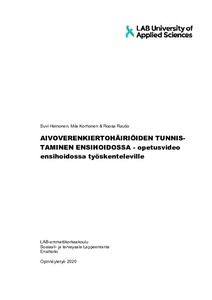Aivoverenkiertohäiriöiden tunnistaminen ensihoidossa - opetusvideo ensihoidossa työskenteleville
Heinonen, Suvi; Korhonen, Mila; Rautio, Roosa (2020)
Heinonen, Suvi
Korhonen, Mila
Rautio, Roosa
2020
All rights reserved. This publication is copyrighted. You may download, display and print it for Your own personal use. Commercial use is prohibited.
Julkaisun pysyvä osoite on
https://urn.fi/URN:NBN:fi:amk-2020112424032
https://urn.fi/URN:NBN:fi:amk-2020112424032
Tiivistelmä
Tämä opinnäytetyö käsittelee aivoverenkiertohäiriöitä ja niiden tunnistamista ensihoidossa. Opinnäytetyön tarkoitus oli selvittää Etelä-Karjalan sosiaali- ja terveyspiirin (Eksote) ensihoitajien haasteita aivoverenkiertohäiriöiden arvioimisessa ja tunnistamisessa, sekä löytää opinnäytetyön avulla niitä osa-alueita, joissa olisi vielä kehittämisen varaa. Tarkoituksena oli tehdä opetusvideo aivoverenkiertohäiriöiden tunnistamisesta Eksoten akuuttihoidossa työskenteleville. Opetusvideo suunniteltiin ja tehtiin yhdessä Eksoten neurologisen poliklinikan ylilääkärin sekä sairaanhoitajan kanssa.
Teoriaosuudessa selvitettiin aivojen sekä keskushermoston anatomiaa ja rakennetta, käsiteltiin eri aivoverenkiertohäiriöt ja niiden oireet sekä tunnistaminen. Opinnäytetyössä käsiteltiin aivoverenkiertohäiriöiden erotusdiagnostiikkaa sairaalan ulkopuolella. Siinä kerrottiin myös ensihoidon palvelujärjestelmästä sekä ensihoidon toiminnasta. Opinnäytetyöhön on etsitty tietoa erilaisista tietokannoista, alan kirjoista ja aiemmin tehdyistä tutkimuksista. Aineistoa etsittäessä on pyritty valitsemaan mahdollisimman luotettavaa sekä uutta tietoa, ja tietoa on haettu lähdekriittisesti.
Alan ammattilaisia haastattelemalla saatiin selville ensihoitajien mielipiteitä aivoverenkiertohäiriöiden tunnistamisen osaamisesta, sekä ehdotuksia siitä, miten tunnistamista voitaisiin parantaa ja missä asioissa haluttaisiin lisäkoulutusta. Näiden haastatteluiden avulla suunniteltiin ja toteutettiin opetusvideo. This thesis is about identifying of Cerebrovascular Disorders in emergency care services. The purpose was to find out South Karelia Social and Health Care District’s (Eksote) paramedics knowledge, difficulties and skills in identifying and evaluation of Cerebrovascular Disorders and to also find out the sections in which paramedics should improve. The main goal was to create an educative video around this subject for the workers in emergency care services.
The theoretical part focused on the anatomy and structure of the brain and central nervous system and dealt with various cerebrovascular disorders, their symptoms and identification. The thesis dealt with the differential diagnosis of cerebrovascular disorders outside the hospital and it also described the emergency care service system and the operation of emergency care. The theoretical data which was collected for this thesis included reliable source of information from literature, internet, reports from previously published reports and interviews of health care professionals who work in different parts of the emergency health care services.
The interviews revealed the views of paramedics on the skills of identifying cerebrovascular disorders, as well as suggestions on how the identification could be improved and on which issues additional training would be desired. Through these interviews, an instructional video was made with the neurological outpatient clinic’s chief neurologist and nurse.
Teoriaosuudessa selvitettiin aivojen sekä keskushermoston anatomiaa ja rakennetta, käsiteltiin eri aivoverenkiertohäiriöt ja niiden oireet sekä tunnistaminen. Opinnäytetyössä käsiteltiin aivoverenkiertohäiriöiden erotusdiagnostiikkaa sairaalan ulkopuolella. Siinä kerrottiin myös ensihoidon palvelujärjestelmästä sekä ensihoidon toiminnasta. Opinnäytetyöhön on etsitty tietoa erilaisista tietokannoista, alan kirjoista ja aiemmin tehdyistä tutkimuksista. Aineistoa etsittäessä on pyritty valitsemaan mahdollisimman luotettavaa sekä uutta tietoa, ja tietoa on haettu lähdekriittisesti.
Alan ammattilaisia haastattelemalla saatiin selville ensihoitajien mielipiteitä aivoverenkiertohäiriöiden tunnistamisen osaamisesta, sekä ehdotuksia siitä, miten tunnistamista voitaisiin parantaa ja missä asioissa haluttaisiin lisäkoulutusta. Näiden haastatteluiden avulla suunniteltiin ja toteutettiin opetusvideo.
The theoretical part focused on the anatomy and structure of the brain and central nervous system and dealt with various cerebrovascular disorders, their symptoms and identification. The thesis dealt with the differential diagnosis of cerebrovascular disorders outside the hospital and it also described the emergency care service system and the operation of emergency care. The theoretical data which was collected for this thesis included reliable source of information from literature, internet, reports from previously published reports and interviews of health care professionals who work in different parts of the emergency health care services.
The interviews revealed the views of paramedics on the skills of identifying cerebrovascular disorders, as well as suggestions on how the identification could be improved and on which issues additional training would be desired. Through these interviews, an instructional video was made with the neurological outpatient clinic’s chief neurologist and nurse.
